Online Orders
Shipping Policy
Coupon Codes & Gift Cards
Returns or Damaged Items
It can become a little overwhelming with all the infinite infinite number of shapes, styles, and sizes of kites. So lets look at some considerations when choosing the right kite for you or your family. When deciding on what kite you should buy, it's helpful to know who will be flying the kite (age & experience), where they plan to fly a kite (open field, beach, lake etc.) and what the variable wind speed might be in that area. Beginners will most likely purchase a single line Delta or Parafoil kite. Most people who purchase a Delta or other similarly graphic kite will include a parafoil with their purchase to ensure they always have something they can fly in most any wind condition. Remember, smaller is not necessarily easier and the less surface area requires more wind. The Large Easy Flyer delta is the perfect size kite for kids of all ages.
We hope the following information will help you navigate the various kites for beginners to advanced kite flyers. Essentially there are three basic kinds of kites:
Single Line
Dual Line (Framed Stunt/Foil)
Multi Line (Power Foil/Arobatic/Speed)
Single Line (Beginner and Intermediate)
The single line is the most common and easiest kite to fly with four different frame types:
- Diamond
- Delta
- Parafoil
- Box (Cellular)
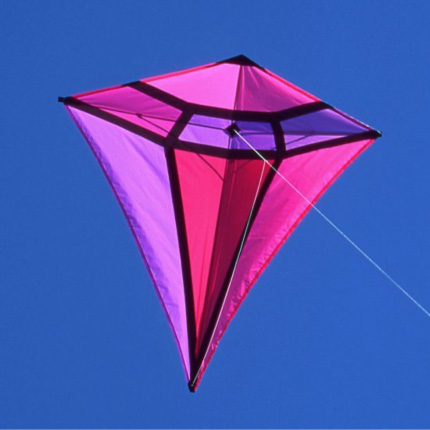
Diamond Kites
The classic diamond kite, also referred as an Eddy kite, have spars positioned vertically and horizontally. These kites are actually the most challenging of single line kites to fly. However they are easy to assemble and popular for kids, do to there small sizes, and are most commonly associated by chasing after a child while running. We recommend flying this type of kite with a tail in winds 5-15 mph. Diamond kites are also used as fighting kites, where the goal is to fray and cut your appoints line. Fighting kite line is often coated with an abrasive to help cut the line when crossed.
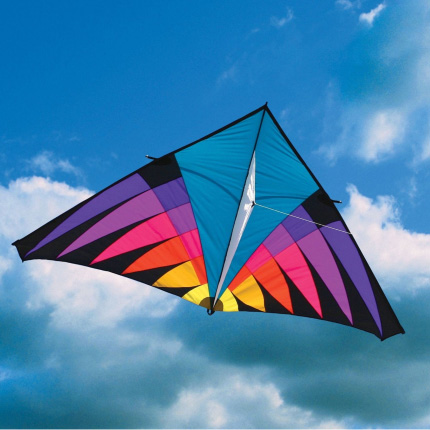
Delta Kites
Delta kites are named after their triangular shape, can be flown in a wide wind range between 5-20 mph, are reliable, easy to fly, making them the perfect kite for both beginners and experienced kiters. Delta kites can be flown with or without a tail, but are most stable when single or multiple tails are attached. Advanced kiters will fly large deltas for their powerful lifting capabilities and will attach line laundry at different heights along the kite line. Deltas make first time flyers feel like experts.
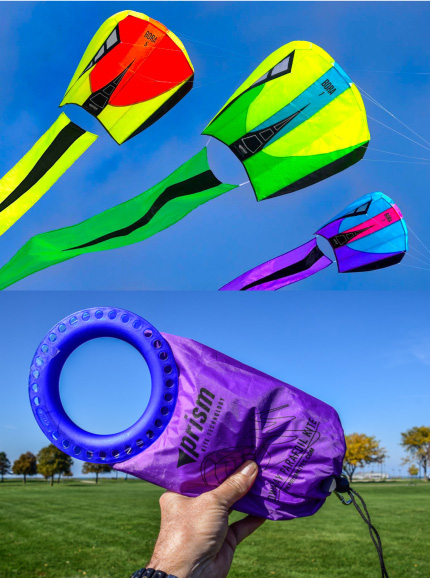
Parafoil Kites
An absolute must have, parafoil’s are table to handle a broad range of wind speeds. They are inflated by the wind having no parts (spars) to assemble or break, and can easily be packed into a pouch and stowed away in a matter of minutes. We recommend flying them between 5-20 mph, and they come in all sizes for beginners, including giant show kites for advanced piloting and show boating. Parafoil sleds are essentially the same as a parafoil with only two baffles that fill with air on the left and right with material in-between and sometimes have a spreader to maintain shape and angle of attack. Do to their powerful and stable lift attributes, they are often used for arial photography.
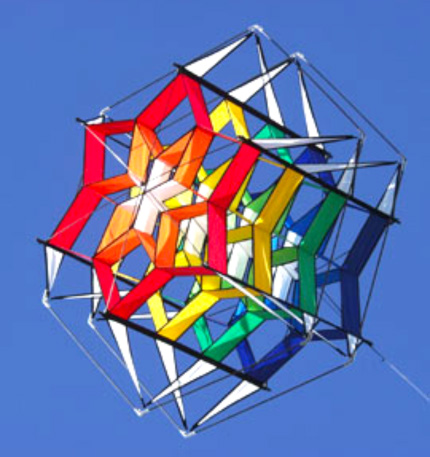
Box (Cellular) Kites
Also know as cellular kites for their unusual and eye catching designs, these kites traditionally require more wind between 8-20 mph. Some of the more advanced cellular designs may have more parts and set up time, but the visual effects are stunning. Hybrid Delta kits are a cross between a box and delta and oft advanced pilots with stronger lifting power for more laundry and altitude. Most box kites are easy to fly, even some styles providing stunning visual effects while spinning or rolling. Traditional box kites were designed to lift appearance into the the sky at high altitudes, such as cameras. They are also used for interior home decoration.
Dual Line (Intermediate to Advanced)
Sport kites are known for there exhilarating speed and acrobatic maneuvers with loops, spins, figure eights, and dives, these kites do require an appreciation for the wind and angle of attack. Also know as stunt, acrobatic, and power kites, there are a wide range of sizes and plenty of styles for the intermediate flyer to learn and get their feet wet. Check out Sport Kites 101
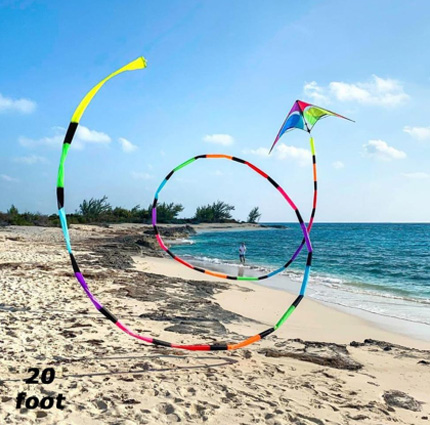
Stunt & Aerobatic Kites
Deltas framed sport kites are the most widely know style of trick stunt kite. They require the greatest appreciation for the wind and your surroundings by pulling off maneuvers faster than foils or power kites. Please remember to be careful of where you fly and the people and pets around you. Stunt kites are fast and both the frame and cordage can cause harm to others. You can learn to fly a stunt kite in as little as an hour, but make sure to select the right kite for your skill level.

Foil & Power Kites
For the power adrenalin junky, foil & power kites are where the action is and don’t worry, there are sizes for all skill levels that won’t rip your arms off. These kites can perform similarly to stunt kites or to “pull” across the terrain, such as a three wheel trike and even skis over snow, if you're up to the challenge. Power kites are even bigger and some even have a third line, which is used as a sheet to increase or decrease power. Also some are amphibious with baffles that are bumped with air, so kites can be launched off or landed in water. Theses kites can all be used as trainer kites for those interested in learning to kite surf.
Multi Line (Power/Stunt/Aerobatic)
Multi-line kites can be anywhere from 3 to 5 line configurations, typical used for Power kite control line set-up. The middle line is usually a safety mechanism used to depower the kite. Quad line set ups are often used with stunt aerobatics kites allowing the pilot to manuver the kite in almost every position within the wind zone. More information regarding advanced flying methods are reviewed under Kites 101.
Quad Line Kites (Advanced)
As described earlier, dual line stunt kites allow you to pilot the kite essentially left and right across the horizon (in front of you). Quad line flying is truly a revolutionary marvel that enables you to move the kite left, right, up, down, and all angles in between. Proficiency in understanding wind direction and angles of attack are essential, which is why quad line kites should only be piloted by experienced kite flyers. If you like challenges, quad line flying is the pinnacle of kite flying and amazing to watch at team kite competitions or kite festivals. Quad line set up is the same kites used for kite surfing.

Kites 101
Our goal with this section is to provide users with a centralized resource whereby they can easily find information on how to fly a kite. We have collected information from online resources, such as manufactures like Prism Kites, who over excellent tutorials and videos that make it a breeze to understand a broad spectrum of flying abilities. We will continue to evolve these pages, so if you have any suggestions, please don't hesitate to email kites@drgravitys.com.
Safe Flying
Wind Speed
Kite Anatomy
Basic Set Up
Getting Started
Trouble Shooting
Safe Flying
Location
Choose a location that is open and free of obstructions, hazards, power lines, and people (see below). Beaches are one of the best spots where consistent wind direction and offers open spaces. Make sure you can fly safely around people and watch out for flying over water and waves, which can damage your kite. Remember pay extra attention when flying multi line kites, which can fly extremely fast and both the cordage and kite can cause injury to humans and animals.
Turbulence
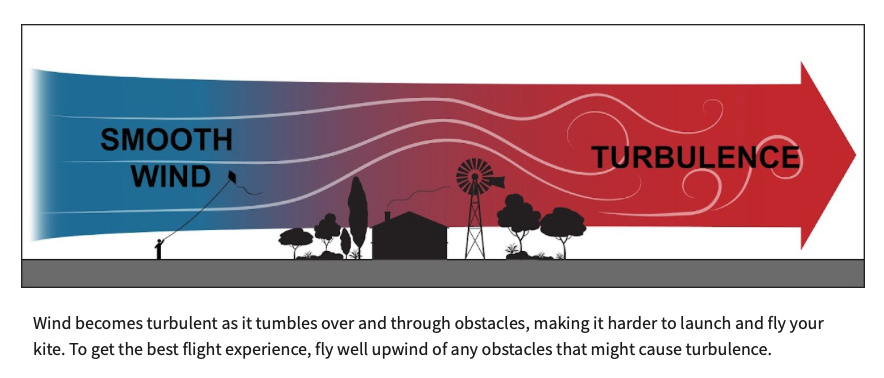
Choose your flying spot carefully to avoid turbulent wind. Like whitewater in a river, wind that flows past obstacles like trees, buildings and hills becomes gusty and choppy and can make launching your kite and keeping it in the air difficult or even impossible.
The best place to fly is an open beach or field with wind blowing in from off the water. If you have such a place available, it's worth the extra travel time to get there because you'll have a much easier time launching and flying your kite. If you have to fly inland, look for wide open fields with no trees, buildings, or hills for at least a quarter mile upwind.

Always be aware of your surroundings and aware of others sharing the space. Be considerate of others as everybody has the right to enjoy public spaces just as much as kite flyers do. Observe local rules and regulations, some parks and beaches restrict kit flying, so it always a best practice to pay attention to sings when entering public places. Again, spectators may not be aware of the inherent dangers from stunt or power kites, so its incumbent upon the kite flyer to communicate to others.
Power Lines
Do not fly your kite near power lines and if your kite manages to get entangled, drop the line, leave the line alone, protect others from getting near the line, contact your local utility, park, or police representative.
Wind Speed
In general wind speeds between 5-20 mph are optimum for most kites. Make sure to check the wind range provided by the particular kite you are using.
| Knots | MPH | Wind Scale Name |
| 4-6 | 4-7 | Leaves rustle, wind felt on arms, light condition |
| 7-10 | 8-12 | Small flags extended, wind felt on face, gentle breeze |
| 11-16 | 13-18 | Standard flags are extended, dust flies, moderate breeze |
| 17-21 | 19-24 | Trees sways, everything moving, performance kites, fresh breeze |
| 22-27 | 25-31 | Trees bend, everything shacking, NOT good flying, string breeze |
Kite Anatomy
Diamond Kite
(similar components and bridal for Dragon and box). Note bridal positioning moving toward the top in high wind and lower for low wind.

Delta Kite
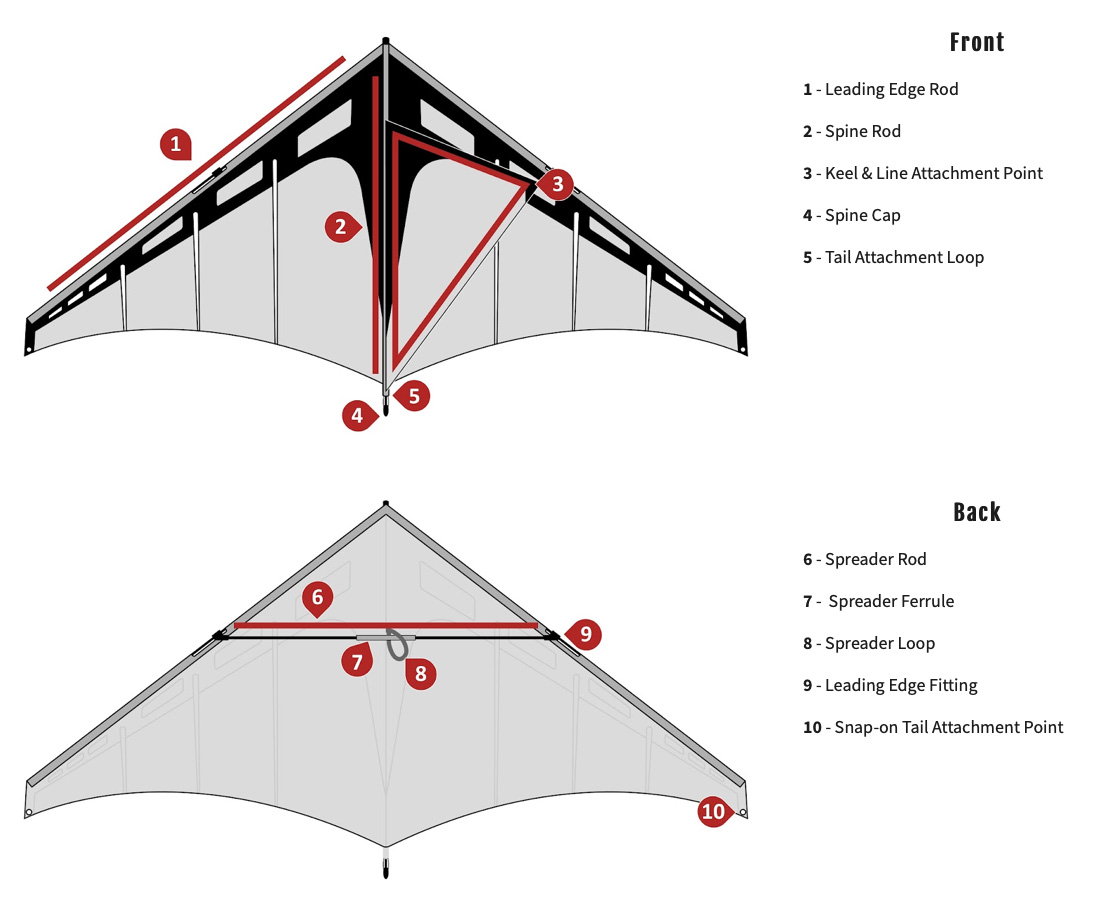 Parafoil Kites (no parts to break and conveniently packs away in a bag)
Parafoil Kites (no parts to break and conveniently packs away in a bag)
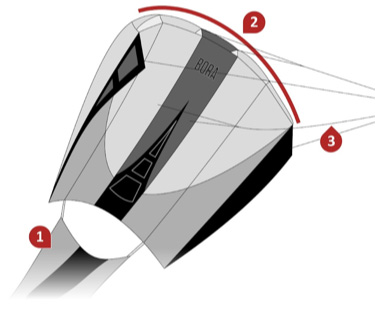
Framed Stunt Kites
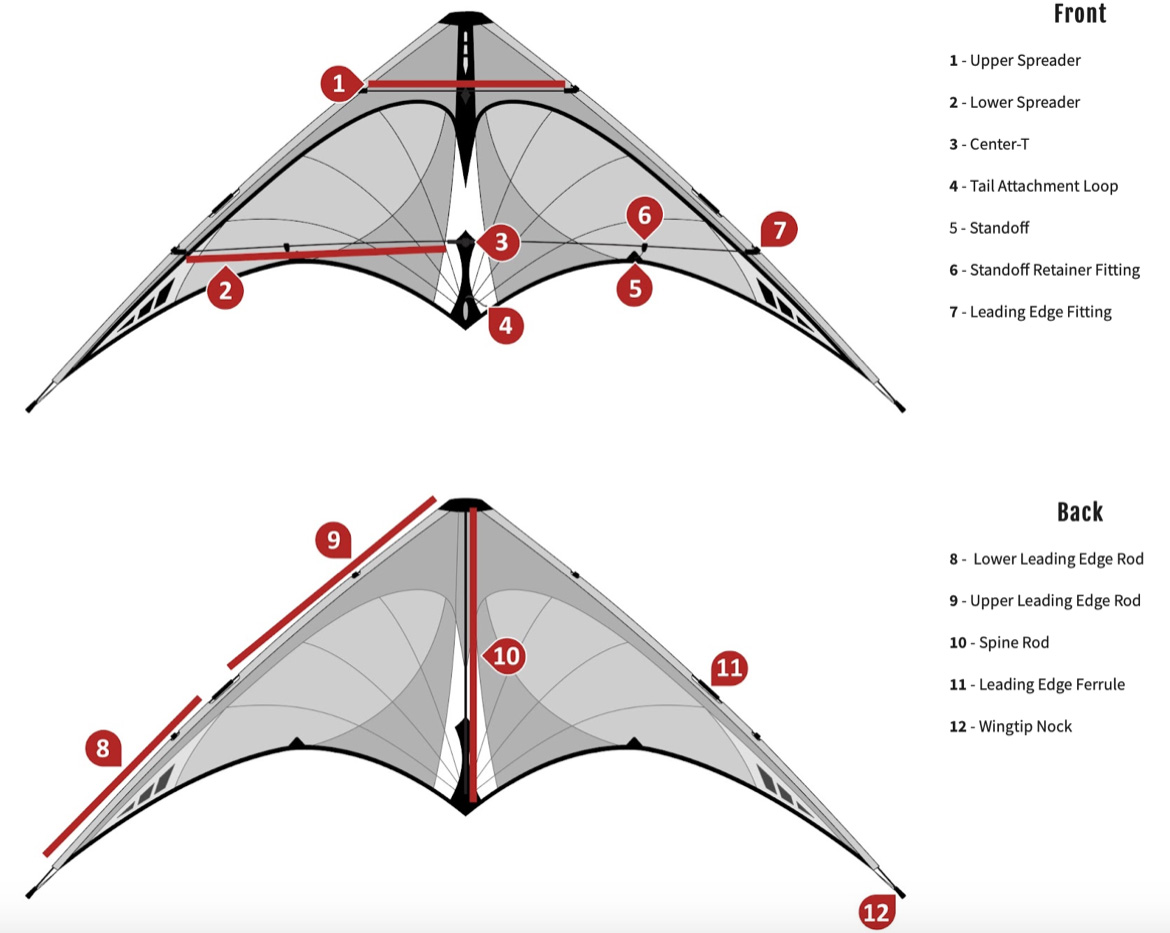
Foil Kites (Dual Line)
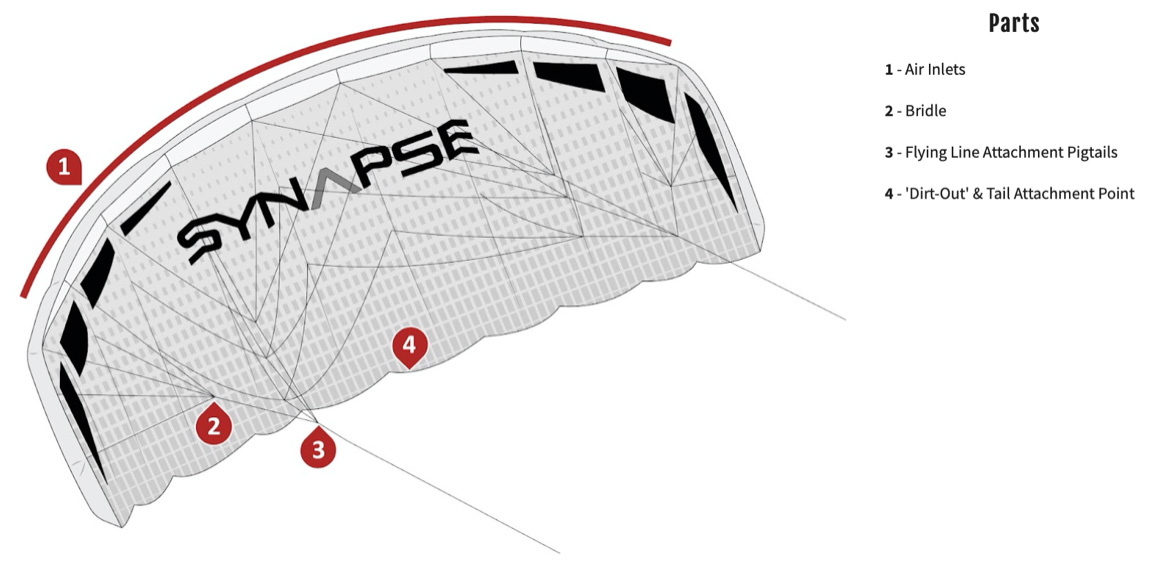
Power Kites (Three Lines)
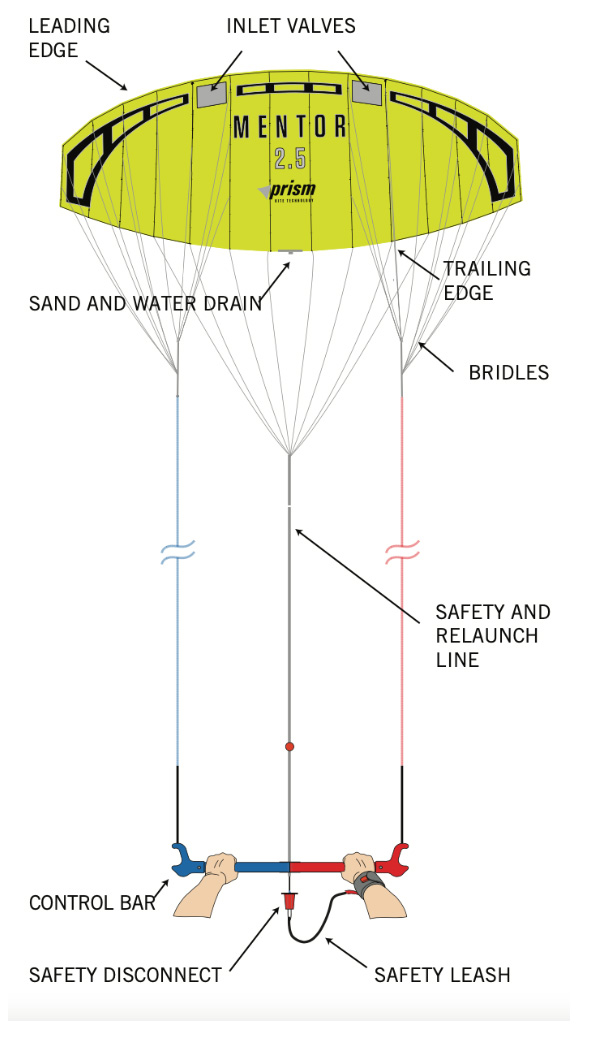
Basic Set Up

Getting Started
Launching

Retrieval

Trouble Shooting
Kite is weaving back and forth, looping, or is having trouble staying airborne
Obstacles disturbing the wind, creating turbulence
If your kite is not flying smoothly, the first thing to consider is the possibility of upwind objects (buildings, trees, etc) creating turbulence. As wind flows over and past obstructions it starts to churn and tumble over itself, similar to whitewater in a rock-filled river. If the wind becomes too turbulent, your kite will have a difficult time staying in place, and may even crash. Adding tails can increase your kite's stability, and letting out more line can help your kite rise above turbulence close to the ground, but if you continue to have trouble you may want to try flying in another area with fewer obstructions upwind.
Too much wind
Every kite has a wind range that describes the upper and lower limits of how much wind it can handle. When flown in more wind than the kite is designed for, the sail may have trouble allowing the wind to flow across and off of it evenly, causing the kite to fly erratically. Wind speed readings offered by weather apps and local news reports are often generalized for a large geographical area, so be aware that the conditions where you are flying may be quite different from those reported. If you are using a portable wind meter or visual indicators to determine the windspeed yourself, consider that the wind speed is often faster up in the air than what can be measured at ground level - when ground level wind speeds are near the top of the suggested wind range for your kite, there is a strong possibility that it will be overpowered by stronger winds once it reaches altitude.
Unsecured Spreader
Make sure that the spreader passes through the loop on the back of the kite. This helps the kite to maintain its shape in stronger winds, and your kite may not fly steady if this is overlooked during assembly.
Kite is turning to one side repeatedly
Broken parts
A broken rod along one of the leading edges of your kite can cause the kite to flex unevenly as the wind pushes against it in flight, causing it to loop or turn consistently in one direction. Check that all parts are intact and free of splits by gently flexing each piece and checking for differences in stiffness, or grating sounds that would suggest a split rod. You can also remove the rods to visually inspect them for damage. If needed, replacement parts are available online at prismkites.com. See the following section of this guide for a direct link to parts for your kite.
Loose leading edge stoppers
Just below the leading edge fittings on your kite (where the spreader connects to the frame), there are black stoppers glued in place to keep the fittings in position and prevent them from sliding further down the rod. Check that both stoppers are secure and have not slid out of place. If one is positioned lower than the other, the kite will likely be locked in a shape that will cause it to turn to one side. A loose stopper can be re-secured with a small drop of superglue if needed - just be sure to match the position of the stopper on the opposite side of the kite before gluing in place.
The following section will provide a general overview of how to fly a Framed Stunt Kite and a Foil or Power Kites.
IMPORTANT: when flying a dual or multi-line kite, take your time when setting up and taking down your lines. Unwind and wind them careful to ensure you don’t have any knots or tangles. This will ensure the quality of flight and longevity of your lines. Tangles and knots can be hard to fix, but luckily they're also very easy to prevent. Just remember this - your flying lines should always be either completely wound onto the included winder, or they should be making a straight line from the wrist straps to the kite. Avoid dragging your flying lines on the ground, unwinding them into a pile at your feet, or taking 'shortcuts' when winding them up at the end of your flight session, otherwise you're likely to end up with a tangled mess as your reward.
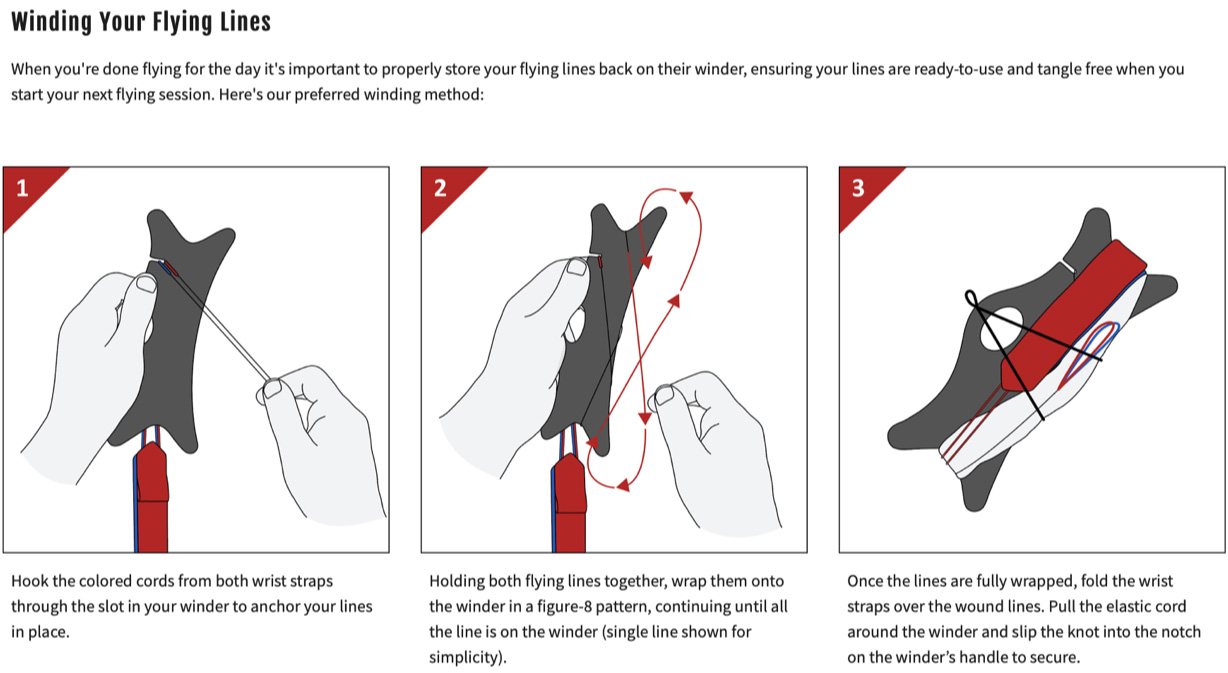
Helpful video tutorial on how to manage your lines
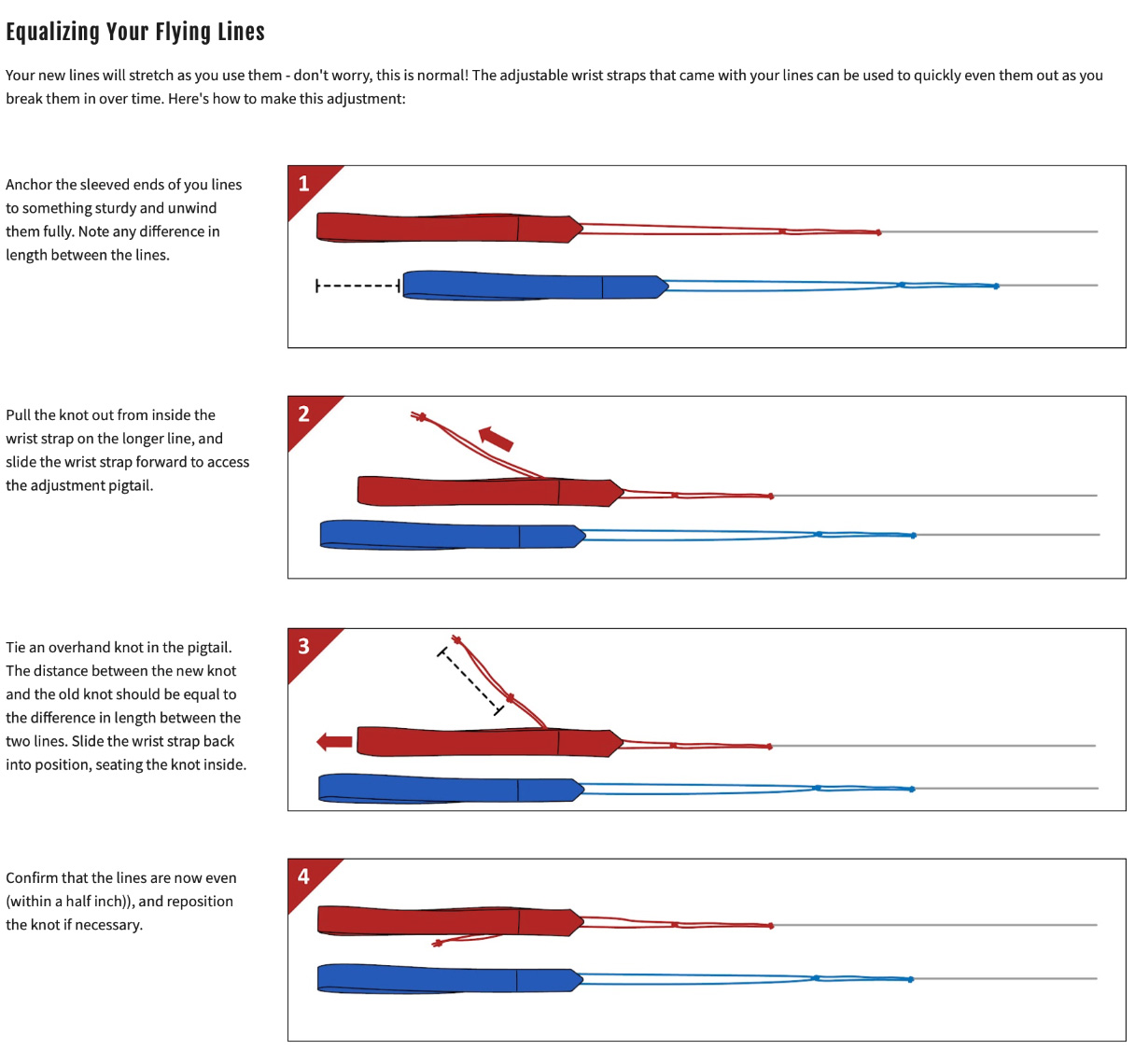
Basic Dual-Line Stunt Flying Tips
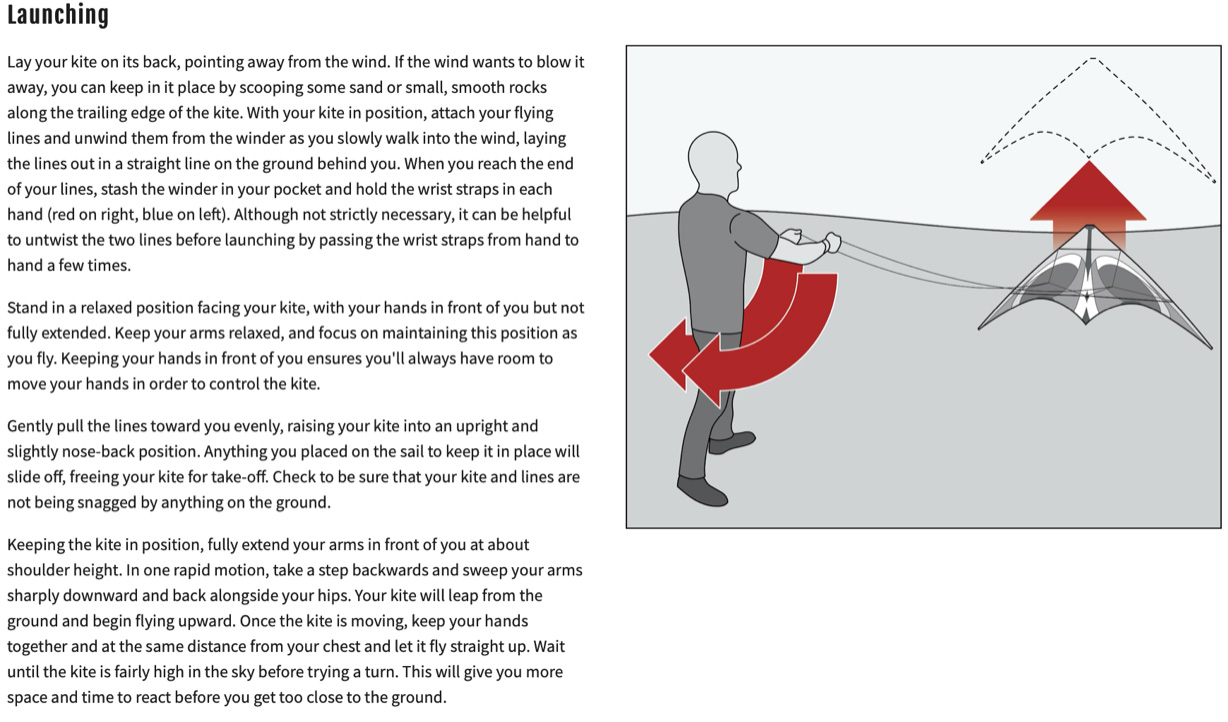
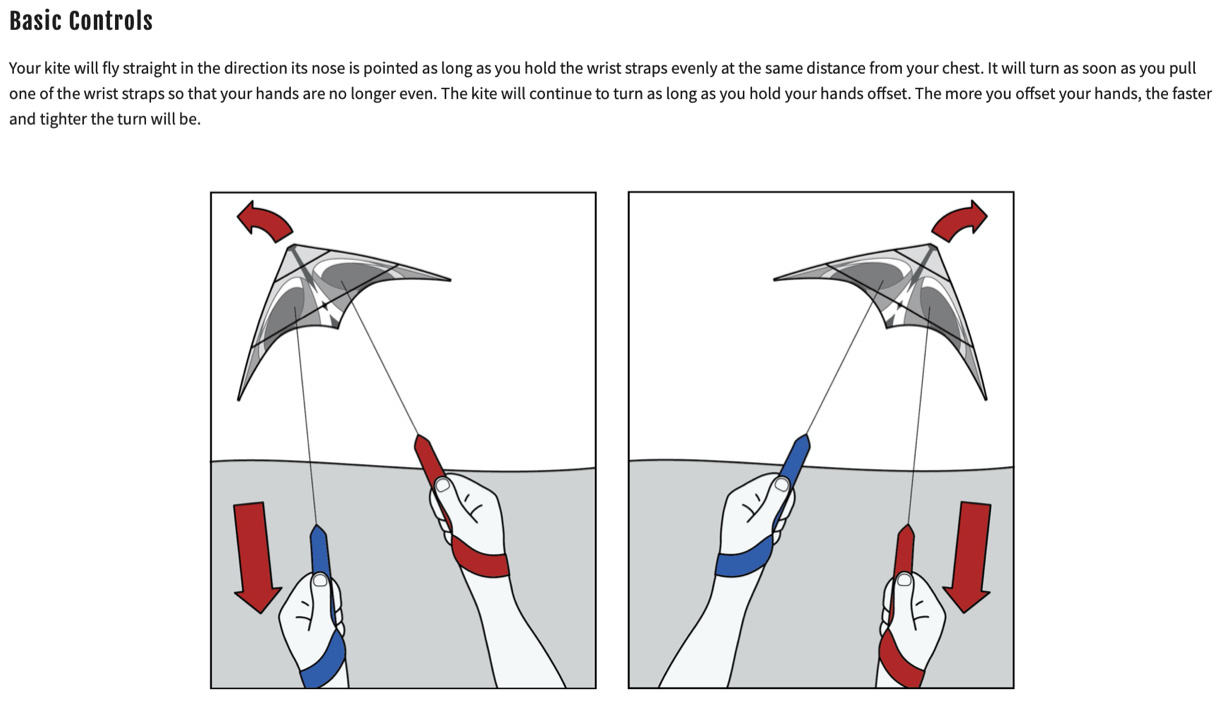

Basic Foil & Power Kite Flying Tips
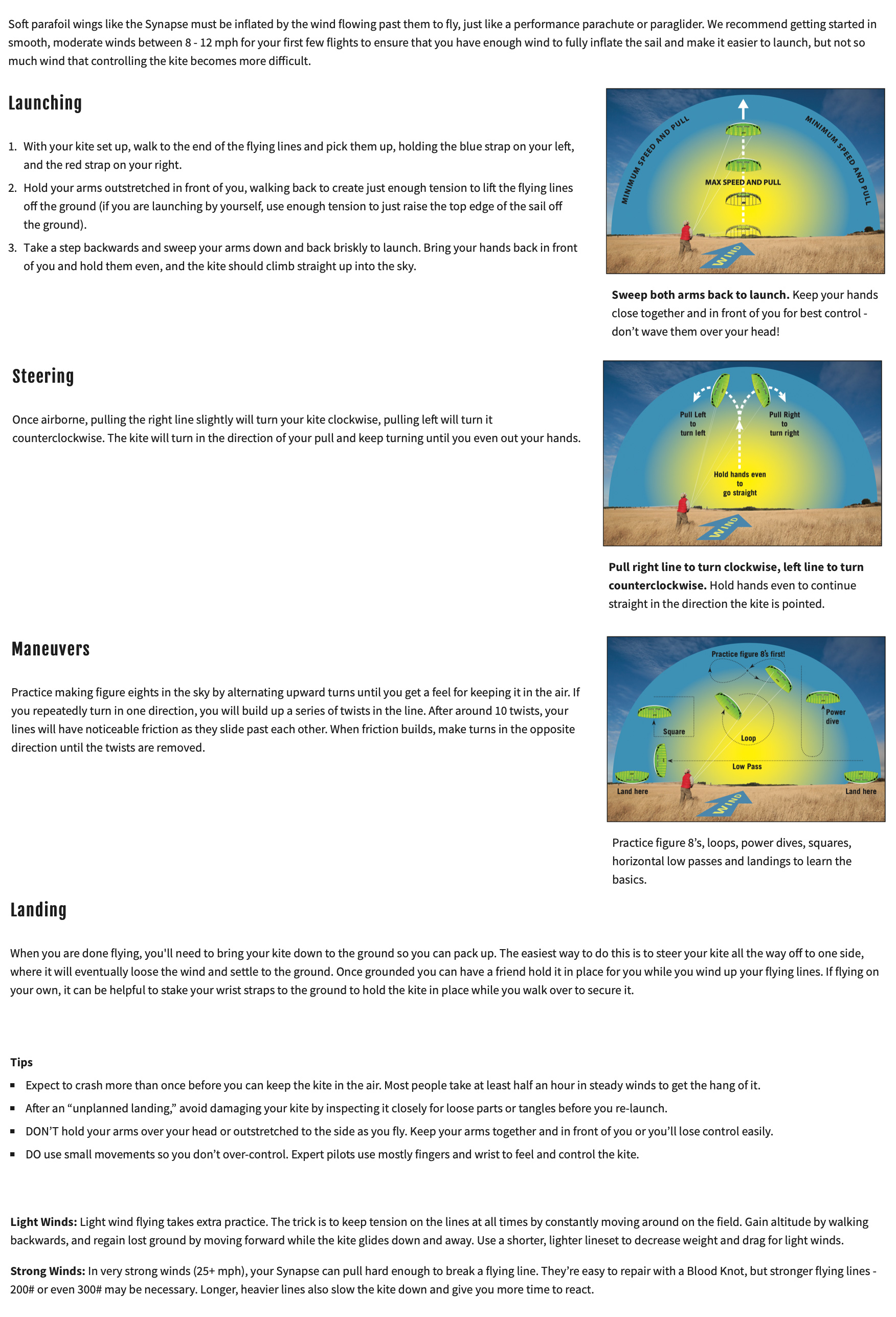
Helpful Video Tutorials
PART 1
PART 2
FREESTYLE PILOT
Monday to Thursday 9am - 10pm
Friday 9am - 10pm
Saturday & Sunday 9am - 10pm
All Online Support Please Call:
774-209-3991
All Questions regarding our Harwich Port, Cape Cod Shop please call:
508-430-0437








